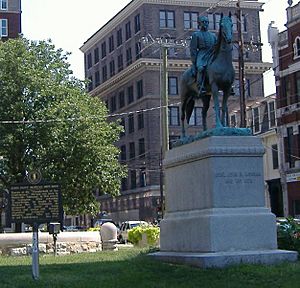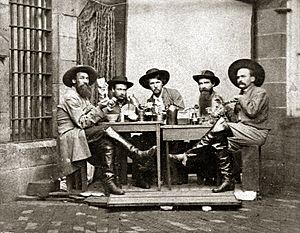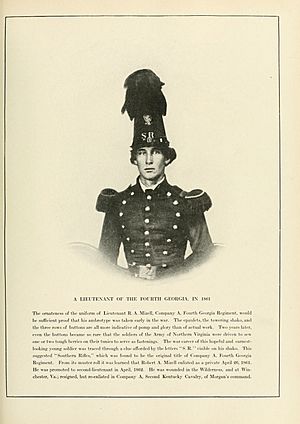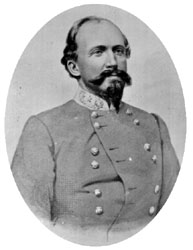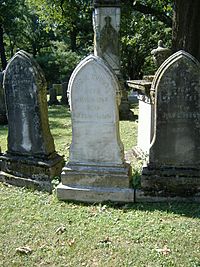John Hunt Morgan facts for kids
Quick facts for kids
John Hunt Morgan
|
|
|---|---|
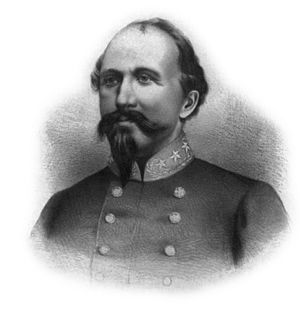
John H. Morgan
Engraving by George Edward Perine (1837–85) |
|
| Nickname(s) | Thunderbolt |
| Born | June 1, 1825 Huntsville, Alabama, U.S. |
| Died | September 4, 1864 (aged 39) Greeneville, Tennessee, U.S. |
| Place of burial |
Lexington Cemetery
|
| Allegiance | |
| Service/ |
|
| Years of service | 1846–1847 (USA) 1857–1861 (Kentucky militia) 1861–1864 (CSA) |
| Rank | Brigadier General (CSA) |
| Battles/wars | |
| Spouse(s) | Rebecca Gratz Bruce Martha Ready |
| Signature | |
John Hunt Morgan (born June 1, 1825 – died September 4, 1864) was an American soldier. He became a general for the Confederate side during the American Civil War (1861–1865). He was known for his daring cavalry raids.
In April 1862, Morgan formed the 2nd Kentucky Cavalry Regiment (CSA). He fought in the Battle of Shiloh in Tennessee. He then led a raid into Kentucky, which helped encourage Confederate General Braxton Bragg to invade that state. Morgan also attacked the supply lines of Union General William Rosecrans.
In July 1863, Morgan led a long raid into Indiana and Ohio. His troops captured many Union soldiers. However, Union gunboats stopped most of his men. Morgan surrendered at Salineville, Ohio, after the Battle of Salineville. This was the farthest north any uniformed Confederates reached. This famous "Morgan's Raid" did not help the Confederacy much. In fact, losing his regiment was a big problem. Some historians believe the raid did help distract Union forces, allowing Bragg's army to escape.
Morgan later escaped from a Union prison. But his reputation was damaged, and he was given smaller tasks. He was killed in Greeneville, Tennessee, in September 1864.
Contents
Early Life and Military Beginnings
John Hunt Morgan was born in Huntsville, Alabama, on June 1, 1825. He was the oldest of ten children. His parents were Calvin and Henrietta Morgan. His mother's father, John Wesley Hunt, was a very successful businessman in Lexington, Kentucky.
When John was young, his family moved to Lexington, Kentucky. He grew up on a farm there. He attended Transylvania College for two years. In 1846, Morgan became a Freemason. He always wanted to be a soldier.
In 1846, Morgan joined the U.S. Army as a private. This was during the Mexican–American War. He was quickly promoted to first lieutenant. He fought in the Battle of Buena Vista. After the war, he returned to Kentucky. He started a business making hemp products. In 1848, he married Rebecca Gratz Bruce.
Morgan stayed interested in the military. In 1857, as tensions grew in the country, he formed an infantry company. It was called the "Lexington Rifles." He spent a lot of time training his men.
Joining the Civil War
At first, Morgan did not support states leaving the Union. But things changed quickly. In September 1861, Morgan and his militia company went to Tennessee. They joined the Confederate States Army. Morgan soon formed the 2nd Kentucky Cavalry Regiment. He became its colonel on April 4, 1862.
Morgan and his cavalry fought at the Battle of Shiloh in Tennessee. This battle took place on April 6–7, 1862. Morgan quickly became a hero for those who wanted Kentucky to join the Confederacy. People hoped that more men like him would help the South win Kentucky and Tennessee.
In his first raid into Kentucky, Morgan left Knoxville, Tennessee, on July 4, 1862. He had almost 900 men. In just three weeks, they rode through Kentucky. They went deep behind Major General Don Carlos Buell's Union army. Morgan reported capturing 1,200 federal soldiers. He also got hundreds of horses and destroyed many supplies.
This raid worried the Union government in Kentucky. President Abraham Lincoln received many urgent requests for help. Historians say Morgan's raid was very impressive. It helped lead to the Confederate Heartland Offensive later that year. Confederate generals thought many Kentuckians would join their army if they invaded the state.
Morgan was promoted to brigadier general on December 11, 1862. This was his highest rank. The Confederate Congress thanked him on May 1, 1863. This was for his raids on Union supply lines. His victory at the Battle of Hartsville on December 7 was especially noted.
On December 14, 1862, Morgan married Martha "Mattie" Ready. She was the daughter of a Tennessee politician.
Morgan's Famous Raid
In the summer of 1863, Morgan started his most famous campaign, known as "Morgan's Raid". He hoped to draw Union troops away from other important battles. These included the Vicksburg and Gettysburg campaigns. Morgan crossed the Ohio River. He then raided across southern Indiana and Ohio.
At Corydon, Indiana, Morgan's raiders met 450 local Home Guard soldiers. This was the Battle of Corydon. Eleven Confederates and five Home Guard members were killed. In Versailles, Indiana, some of Morgan's soldiers stole jewels from a local Freemason lodge. When Morgan, who was also a Freemason, found out, he made sure the jewels were returned.
After more small fights, Morgan's raid almost ended on July 19, 1863. This was at Buffington Island, Ohio. About 700 of his men were captured while trying to cross the Ohio River. Union gunboats stopped them. Over 300 men did manage to cross. Most of Morgan's captured men spent the rest of the war in Camp Douglas prison in Chicago. This camp had a very high death rate.
On July 26, near Salineville, Ohio, Morgan and his tired soldiers were forced to surrender. This was the farthest north that any uniformed Confederate troops went during the war.
On November 27, Morgan and six of his officers escaped from the Ohio Penitentiary. They dug a tunnel and climbed a wall. Morgan and three officers boarded a train. They escaped into Kentucky by crossing the Ohio River. With help from supporters, they reached safety in the South.
Morgan's Raid was very exciting for people in both the North and South. It worried Union leaders. But today, it is seen as a showy event that did not change the war much. Morgan had also ignored orders from General Braxton Bragg not to cross the river. The Union had many soldiers, gunboats, and cavalry ready. This made the raid very difficult from the start. The raid cost the Union a lot of money. However, the Confederacy lost Morgan's skilled cavalry. This loss was much greater than any benefits from the raid.
Later Military Actions and Death
After escaping prison, Morgan returned to duty. But the new soldiers he was given were not as good as the ones he had lost. Morgan started raiding into Kentucky again. However, his men were not as disciplined. They often looted, and many were killed. These raids were very risky. The Union had taken stronger control of the border states. This made it harder for raiders to escape. The anger in the North over Morgan's Ohio raid likely led to this stronger Union presence.
His "Last Kentucky Raid" happened in June 1864. The most important part was the Second Battle of Cynthiana. Morgan won a small fight on June 11. But the next day, he decided to fight stronger Union forces. This was a disaster for the Confederates. Morgan's force was mostly destroyed. Only a few, including Morgan and some officers, escaped.
General Bragg no longer trusted Morgan after the unauthorized Ohio raid. Still, on August 22, 1864, Morgan was put in charge of the Trans-Allegheny Department. This included Confederate forces in eastern Tennessee and southwestern Virginia. But some Confederate leaders were looking into charges against Morgan. This likely led to his removal from command. He began planning a raid on Knoxville, Tennessee.
On September 4, 1864, Union cavalry surprised Morgan in Greeneville, Tennessee. As he tried to escape, he was shot in the back and killed.
Morgan was buried in Lexington Cemetery.
Legacy
- Many places remember John Hunt Morgan.
- Hart County High School in Munfordville, Kentucky, calls its mascot the Raiders. This is in honor of Morgan's men. There is also a large mural of Morgan in the town.
- Trimble County High School in Bedford, Kentucky, also named its mascot the Raiders.
- The John Hunt Morgan Memorial statue in Lexington honors him. It was moved to the Confederate section of the Lexington Cemetery in 2018.
- The Hunt–Morgan House, which was once his home, is a historic building in Lexington.
- Two bridges are named after him: one in Abingdon, Virginia, and one in Cynthiana, Kentucky.
- The General Morgan Inn in Greeneville, Tennessee, is named after him. This is where he was killed.
- A Kentucky Army National Guard unit is known as Morgan's Men.
- In West Point, Ohio, a stone monument was put up in 1909. It marks where Morgan surrendered. It says:
This stone marks the spot where the Confederate raider General John H. Morgan surrendered his command to Major General George W. Rue, July 26, 1863, and this is the farthest point north ever reached by any body of Confederate troops during the Civil War."


